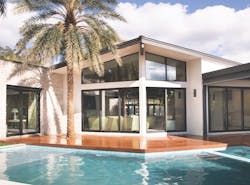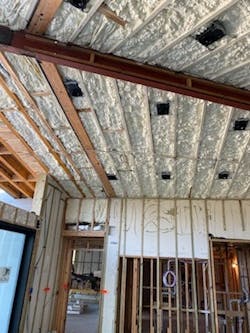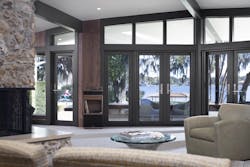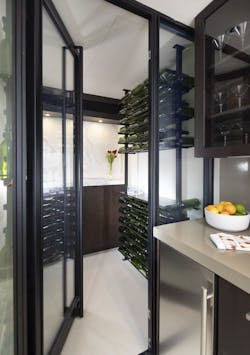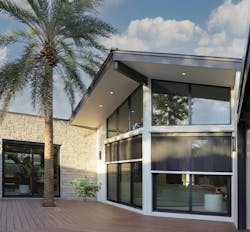The New American Remodel 2022: Performance Showcase
How do you transform a historic home into a thermal performance thoroughbred without sacrificing its charm? Answering that question was the theme of The New American Remodel 2022 in Orlando.
Although the finished home included new additions, the architectural core of the 1960s-built Frank Lloyd Wright-style structure had to be preserved. That core consisted of a wood-paneled central great room with a cathedral ceiling that extended from the front of the house to the back. Expansive windows and doors filled the gables at either end.
The remodeled central room would need to look and feel like a mid-20th-century time capsule, but the home would also have to earn certifications from stringent contemporary performance programs: Net Zero Ready, Indoor airPLUS, WaterSense, and Emerald certification from the National Green Building Standard.
The home earned all those certifications thanks in large part to performance and sustainability consultant Drew Smith of Two Trails, who has been part of the TNAR program every year since its inception.
The home has 12.8 KW of high-efficiency Solaria solar panels. They offset 100% of the annual electric needs. Photo: Jeffrey Davis Photography
RELATED: TNAR 2022: Modernizing a Classic
Modeling a Remodel
In any remodeling project, working with existing architecture results in more variables compared with a high-performance new home. There has to be a measurable reduction of heating and cooling loads over the existing home at a reasonable cost.
The first step to measuring these improvements is to define the baseline. This means the performance consultant enters the home’s parameters (insulation levels, glazing U-values, and HVAC system efficiency, for example) into a piece of energy modeling software and might even perform a blower door test to gauge air leakage.
Data from the software and blower door test is used to score the home on the Home Energy Rating System (HERS) Index, which is becoming a standard performance metric for U.S. housing.
“The preliminary HERS Index score is a snapshot of the home’s efficiency,” says Smith. “It helps us set goals and decide how best to achieve those goals.”
Want to hear more about the systems, products, and processes of getting The New American Remodel 2022 to a HERS Index of -28? Watch our performance webinar with Drew Smith, architect Phil Kean, and remodeler Eric Gray here.
On The New American Remodel, the Two Trails team calculated a pre-remodel HERS Index of 115, which is 15% less efficient than today’s average new code-built home.
To qualify for Net Zero, a rooftop solar array needs to generate more electricity than the home uses on an annual basis. A HERS score of 0 would technically meet that requirement, but Smith says it’s not good enough in reality. “The actual electrical usage depends on the occupants’ lifestyle,” he says. “To guarantee no electric bill, I aim for at least -10.” This home did much better, with a final score of HERS -28, the second-best score in Smith’s consulting history.
Of course, The New American Remodel is a show home, so the design team always sets ambitious performance goals. However, the principles and approaches apply to any project.
RELATED: Marketing Lessons From The New American Remodel 2022
Choosing Products
A baseline, pre-remodel performance score is an absolute must if the remodeler and architect want to accurately gauge which features and products offer the most performance bang for the budget. The homeowners can then use this information to make thoughtful product decisions.
For instance, a common goal is for the monthly energy cost savings achieved by the upgrades to exceed the cost that those upgrades add to the final mortgage payment. You can’t calculate those savings without a baseline.
Take the example of glass. In a home with lots of windows, like the ones at either end of The New American Remodel’s central room, glazing is important, but performance isn’t the sole criteria—the windows must also work with the architecture.
Spray foam was used in walls and ceilings. Shown here is the cathedral ceiling over the central great room, which made it impossible to run ductwork from one side of the house to the other. That required two separate HVAC systems.
Smith and his team typically provide the architects with several window and door options. Using performance data from the manufacturer (U-value and solar heat gain coefficient), they calculate the effect each option will have on home energy use.
“We work closely with the architect and run our calculations at the same time the design is being done,” says Smith. “It’s a constant stream of what-ifs.”
Those what-ifs include answering questions like how much an extra $10,000 spent on better windows will improve the HERS score and how much it will lower the monthly electric bill compared to less-expensive units.
The final choices for The New American Remodel included Jeld-Wen and LaCantina windows and doors with approximate U-values of 0.3 and Solar heat gain coefficients (SHGC) of 0.2 to limit solar heat gain.
High-efficiency Jeld-Wen windows and sliding doors help keep conditioned air in, while mitigating the effects of the bright Florida sun in spots where the architecture didn't allow for much shading. Photo: Jeffrey Davis Photography
Smith uses the same what-if process when choosing other features. These include type, amount, and locations of insulation products and the HVAC system.
RELATED: Contemporary Living With Period Flair
Mechanical Challenges
One of the most challenging aspects of this project was the HVAC design. “The home presented a huge constraint,” says Smith.
The central great room is flanked by a primary suite and wine room on one side and a kitchen and guest bedroom on the other. However, the cathedral ceiling and slab-on-grade floor leave no way to run ductwork from one side of the house to the other, so the home needed two heat pumps, one for each side.
It’s a high-efficiency system from Mitsubishi Electric Trane US, the project’s HVAC partner, with a total cooling capacity, including the two condensers, of 6 tons.
Of course, it’s not unheard of to have two heat pumps for a 3,600 square foot home. What’s unusual with this home is that there’s very little room for ductwork. For instance, air had to be delivered to the great room via wall registers high up on the wall on either side of the room. “We built ducts inside those walls with returns at floor level,” says Smith.
Ceiling heights in the rooms on either side of the central great room presented another issue. The 8-foot high ceiling in the primary bedroom was already low compared to most of today’s luxury homes. There was also no attic space above the ceiling, meaning it had to be lowered further to make room for ducts.
But the most difficult constraint was the limited space available for the indoor air handlers. The floor plan didn’t accommodate mechanical closets so the only available spaces were the tiny attic cavities over the kitchen on one side of the house and over the wine room on the other.
Those attic cavities are really cramped—the one above the kitchen is maybe 4 feet tall at its highest point, then gets smaller towards the eaves. That, and an equally small cavity over the wine room, were all Smith had available.
Working closely with Mitsubishi, he was able to engineer a system that included horizontal air handlers that were small enough to squeeze into the available space yet, when paired with a creative duct layout, powerful enough to deliver the needed airflow to all rooms.
The wine room featuring an HVAC access panel. Photo: Jeffrey Davis Photography
RELATED: Webinar: Lessons in Preservation from The New American Remodel 2022
Other Features and Benefits
As a high-performance home, it should come as no surprise that The New American Remodel included many other products that helped it hit the Net Zero target.
All lighting is LED. Cavities in the exterior CMU walls (a common construction method in Florida) were filled with spray foam insulation. Spray foam was also used to insulate the roof system. The structure also has a layer of Fi-Foil reflective insulation to further increase R-value.
The home got a final air seal from a product called Aerobarrier, sometimes called “Fix-a-Flat for homes.” The applicator sprays foam aerosol into the home’s air, then uses a blower door to pressurize the house and force the aerosol into any unsealed gaps, making the home super tight.
Phantom Screens keep pests and the Florida sun out. Photo: Jeffrey Davis Photography
As mentioned above, Smith combined these products to achieve a final HERS Index score of -28. This is more than a nice-to-have feature: changes to the Multiple Listing Service (MLS) help make a high-performance home more valuable at resale.
HERS scores, program certifications, and other green features can now be added to listings in some areas. Smith estimates that the green features in The New American Remodel will add between 5 and 15% to its appraised value, which is another way to justify the cost of performance upgrades.
The broker has to add those features to the listing, but it’s worth insisting that they do so. “They’re doing the seller a disservice if they do not list all of the green/energy features as well as all of the certifications the home received,” says Smith. “This should help increase the appraisal value as long as they find equal comps.”
